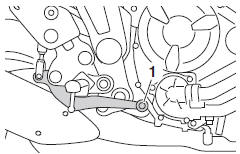 Yamaha XSR700 - Owner's Manual > Clutch lever
Yamaha XSR700 - Owner's Manual > Clutch lever

- Clutch lever
The clutch lever is located on the left side of the handlebar. To disengage the clutch, pull the lever toward the handlebar grip. To engage the clutch, release the lever. The lever should be pulled rapidly and released slowly for smooth clutch operation.
The clutch lever is equipped with a clutch switch, which is part of the ignition circuit cut-off system.
Shift pedal

- Shift pedal
The shift pedal is located on the left side of the motorcycle. To shift the transmission to a higher gear, move the shift pedal up. To shift the transmission to a lower gear, move the shift pedal down.
Brake lever
The brake lever is located on the right side of the handlebar. To apply the front brake, pull the lever toward the throttle grip.

- Brake lever
- Distance between brake lever and throttle grip
- Brake lever position adjusting dial
- Match mark
The brake lever is equipped with a brake lever position adjusting dial. To adjust the distance between the brake lever and the throttle grip, push the brake lever away from the throttle grip and rotate the adjusting dial. Make sure the setting number on the adjusting dial aligns with the match mark on the brake lever.
Brake pedal

- Brake pedal
The brake pedal is located on the right side of the motorcycle. To apply the rear brake, press down on the brake pedal.
ABS
The Yamaha ABS (Anti-lock Brake System) features a dual electronic control system, which acts on the front and rear brakes independently.
Operate the brakes with ABS as you would conventional brakes. If the ABS is activated, a pulsating sensation may be felt at the brake lever or brake pedal.
In this situation, continue to apply the brakes and let the ABS work; do not "pump" the brakes as this will reduce braking effectiveness.
WARNING
Always keep a sufficient distance from the vehicle ahead to match the riding speed even with ABS
- The ABS performs best with long braking distances.
- On certain surfaces, such as rough or gravel roads, the braking distance may be longer with the ABS than without.
The ABS is monitored by an ECU, which will revert the system to conventional braking if a malfunction occurs.
TIP
- The ABS performs a self-diagnosis test each time the vehicle first starts off after the key is turned to "ON" and the vehicle has traveled at a speed of 10 km/h (6 mi/h) or higher. During this test, a "clicking" noise can be heard from the hydraulic control unit, and if the brake lever or brake pedal is even slightly applied, a vibration can be felt at the lever and pedal, but these do not indicate a malfunction.
- This ABS has a test mode which
allows the owner to experience
the pulsation at the brake lever or
brake pedal when the ABS is operating.
However, special tools are required, so please consult your Yamaha dealer.
NOTICE
Be careful not to damage the wheel sensor or wheel sensor rotor; otherwise, improper performance of the ABS will result.

- Front wheel sensor
- Front wheel sensor rotor

- Rear wheel sensor
- Rear wheel sensor rotor
See also:
 Yamaha XSR700 - Owner's Manual > Handlebar switches
Yamaha XSR700 - Owner's Manual > Handlebar switches
Left Pass switch " " Dimmer switch " "
 Yamaha XSR700 - Owner's Manual > Fuel tank cap
Yamaha XSR700 - Owner's Manual > Fuel tank cap
Fuel tank cap lock cover Unlock. To open the fuel tank cap
 Ducati Scrambler
Ducati Scrambler Fantic Caballero 500
Fantic Caballero 500 Indian FTR 1200
Indian FTR 1200 Moto Guzzi V85 TT
Moto Guzzi V85 TT Royal Enfield Bullet Trials Works Replica
Royal Enfield Bullet Trials Works Replica Triumph Scrambler 1200 XE
Triumph Scrambler 1200 XE Triumph Street Scrambler
Triumph Street Scrambler Yamaha XSR700
Yamaha XSR700 Ducati Scrambler 800
Ducati Scrambler 800 Moto Guzzi V85 TT
Moto Guzzi V85 TT Triumph Scrambler 1200 XC
Triumph Scrambler 1200 XC